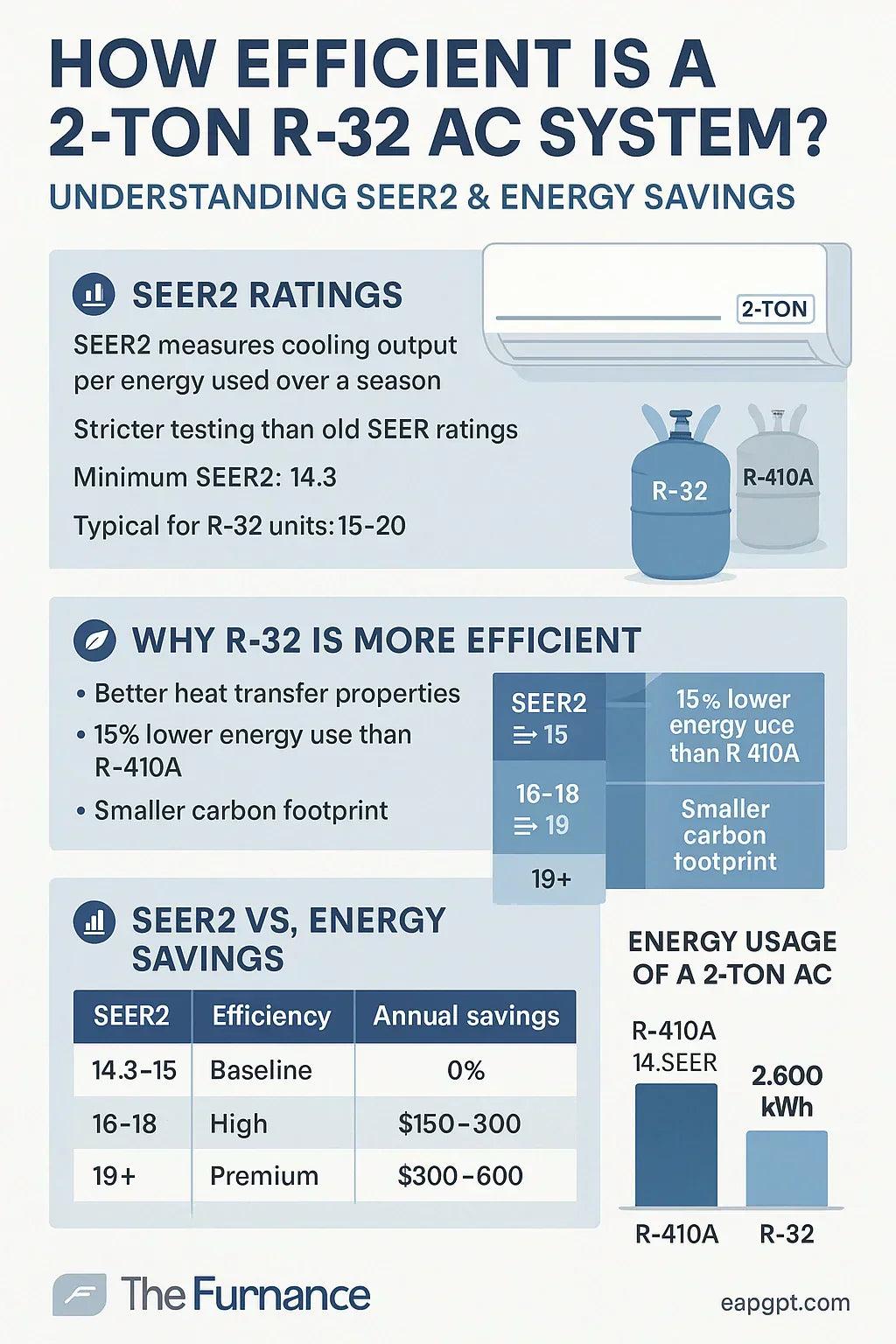🏠 Introduction: Why Efficiency Matters More in 2025
When I decided to upgrade my old air conditioner, efficiency was at the top of my list. Energy bills have climbed, summers are hotter, and homeowners like me are more conscious about our environmental impact than ever before. That’s why I chose a 2‑ton R‑32 air conditioner, designed to meet new SEER2 efficiency standards in 2025.
This article breaks down how SEER2 works, why R‑32 refrigerant is a game‑changer, and what kind of energy savings you can realistically expect.
📊 SEER2 Explained: The New Gold Standard
🔎 What Is SEER2?
SEER2 stands for Seasonal Energy Efficiency Ratio 2. It measures how efficiently an air conditioner cools your home over an entire cooling season. Think of it as miles‑per‑gallon (MPG) for your AC.
The formula is:
SEER2 = Cooling Output (BTUs) ÷ Energy Input (Watt‑hours)
🆚 SEER vs. SEER2
The older SEER standard often overestimated efficiency because it used less realistic lab conditions. SEER2 uses stricter testing protocols set by the U.S. Department of Energy to simulate real‑world conditions
-
Old minimum (SEER): 14
-
New minimum (SEER2): 13.4 for split systems in most regions
📈 Typical SEER2 for 2‑Ton R‑32 Systems
Most modern 2‑ton R‑32 systems fall between 15 and 18 SEER2, with premium models reaching 20+ SEER2
Samantha’s Tip: Always check the yellow EnergyGuide label. Higher SEER2 means bigger savings, even if the upfront cost is higher.
🌱 Why R‑32 Improves Efficiency
🔬 Thermodynamic Advantages
Compared to older R‑410A refrigerant, R‑32 transfers heat more effectively. This means:
-
Lower compressor workload
-
Faster cooling cycles
-
Consistent temperature control (Daikin.com)
📉 Lower Refrigerant Volume
R‑32 systems typically use 20–30% less refrigerant than R‑410A units for the same cooling output. Less refrigerant means less energy required to compress and circulate it.
⚡ Real‑World Results
After upgrading, my summer electricity bills dropped by about 15% compared to my old R‑410A system. That’s hundreds of dollars saved each year—without sacrificing comfort.
💡 Real‑World Energy Savings
🔢 Estimated kWh Savings
Let’s say your old 14 SEER system consumed 3,000 kWh per cooling season. Switching to a 16 SEER2 R‑32 system could cut that down to ~2,600 kWh. At a national average of $0.16 per kWh (EIA.gov), that’s about $64 saved per season.
🌡️ Climate Impact
-
Hot & Humid (e.g., Florida, Texas): Up to $300–$500 savings per year
-
Moderate (e.g., Virginia, Oregon): $150–$300 savings per year
-
Cool (e.g., Minnesota, Maine): $100–$200 savings per year
Case Study (My Home in Texas):
Before: 14 SEER, ~$200/month in peak summer
After: 16.5 SEER2 R‑32, ~$170/month in peak summer
That’s a 15% reduction—and it adds up fast.
🏡 Home Factors That Affect Efficiency
Even the best AC system won’t perform well if your home isn’t set up for it. Here’s what I learned:
🧱 Insulation & Windows
Poor insulation lets cool air escape, forcing your AC to run longer. Adding attic insulation improved my comfort instantly.
🌀 Ductwork Design & Sealing
Leaky ducts waste 20–30% of conditioned air (EPA.gov). My contractor sealed leaks with mastic, cutting waste significantly.
📏 Ceiling Height & Layout
Open floor plans and high ceilings need more cooling power. My installer adjusted airflow to keep temperatures consistent.
👨👩👧 Occupant Load
More people = more body heat. My family of four definitely influences how often the AC cycles.
📈 Cost Savings Over Time
💵 15‑Year Savings Example
-
Old 14 SEER (R‑410A): ~$750/year in electricity
-
New 16.5 SEER2 (R‑32): ~$630/year
-
Annual Savings: ~$120
-
15‑Year Savings: ~$1,800
If the unit costs $500–$800 more upfront, you still come out ahead—especially with rebates.
🎯 Payback Period
With rebates and tax credits, the payback period for a high‑efficiency R‑32 system is often 3–5 years. After that, it’s pure savings.
🎁 Rebates, Tax Credits & Incentives in 2025
🏷️ Federal Tax Credits
The Inflation Reduction Act offers up to $2,000 in federal tax credits for qualifying high‑efficiency AC and heat pump systems.
💡 State & Utility Rebates
Many utilities offer $200–$1,000 rebates for R‑32 systems that meet ENERGY STAR requirements (DSIREusa.org).
🌍 My Experience
I qualified for both a federal tax credit and a $800 utility rebate, reducing my upfront cost by nearly $3,000.
📊 SEER2 Comparison Table
| SEER2 Rating | Efficiency Level | Typical Annual Savings vs. 14 SEER |
|---|---|---|
| 14.3–15 | Baseline (minimum) | – |
| 16–18 | High efficiency | $150–$300 |
| 19+ | Premium efficiency | $300–$600 |
✅ Samantha’s Takeaway: Is It Worth It?
Here’s my bottom line:
-
Yes, a 2‑ton R‑32 AC system is absolutely worth it.
-
The higher SEER2 rating plus R‑32 refrigerant delivers lower bills and better comfort.
-
Rebates and tax credits in 2025 make the upgrade even more affordable.
-
The system essentially pays for itself within a few years and continues to save money for over a decade.
If you’re debating whether to stick with an older R‑410A unit or invest in R‑32, I’d say: don’t wait. The savings—and peace of mind—make it the smarter choice.
In the next topic we will know more about: DIY or Hire a Pro? Installing a 2-Ton R-32 System Step by Step







